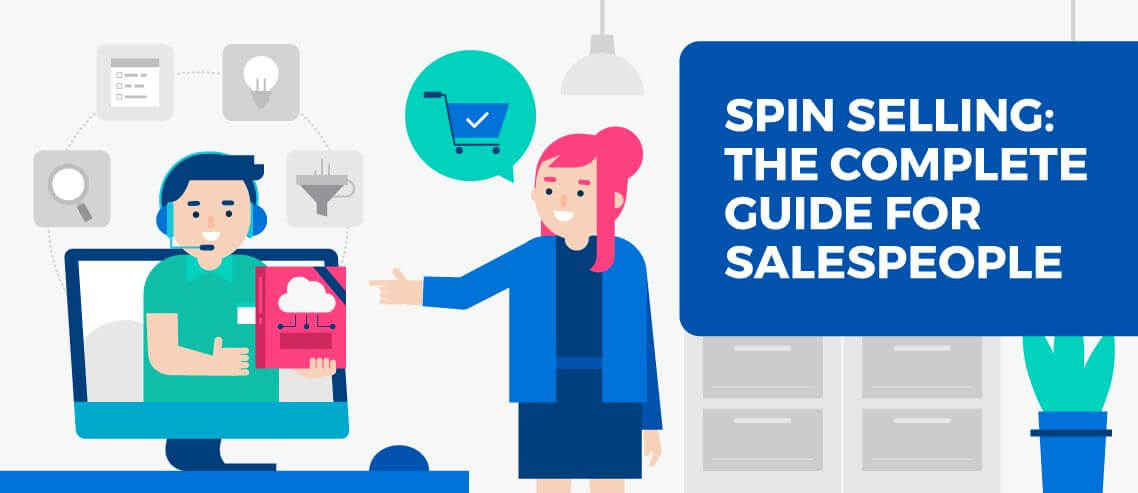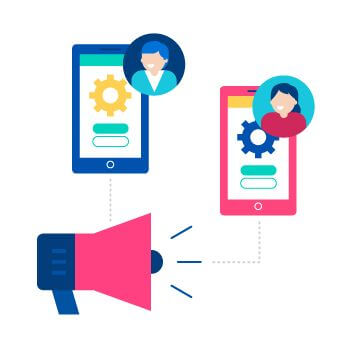SPIN Selling: The Complete Guide for Salespeople

Contents
When someone receives a call from one of your salespeople, are they more likely to feel as though they’ve just been hit with a sales pitch, or that someone was genuinely interested in helping them to solve their problems?
If you’re using the SPIN selling technique, they should feel the latter, and research suggests that this is more likely to result in a sale. With that in mind, here’s everything you need to know about SPIN selling.
What Is SPIN Selling?
SPIN selling is a sales method based on the book SPIN Selling by Neil Rackham. A best-selling author, Rackham and his team spent 30 years studying over 35,000 sales calls.
What he found was that the most successful calls followed a distinct pattern.
Rather than actively pushing the idea of buying, salespeople allowed it to grow more organically through a series of questions. As Rackham says, “my objective is not to close the sale but to open a relationship.”
The most successful salespeople initiated conversations that opened a relationship with the prospect, and to do this, they asked questions in a very distinct order. These questions fell into four categories:
- Situation
- Problem
- Implication
- Need-Payoff
By asking the right questions, SPIN selling enables your salespeople to build better relationships that ultimately result in more sales.
What are the SPIN Selling Phases?
SPIN selling phases are broken down into four phases. Each one builds on the previous phases and allows your salespeople to gain important insights into the customer.
1. Situation Phase
SPIN selling aims to change the focus of your salespeople. Of course, they still need to make sales, but this comes through focusing on the customer first.
In all forms of marketing, businesses can become too focused on their own goals, neglecting the actual pain points that customers have. This is typified by a salesperson just running straight into their sales pitch without taking time to understand the customer’s situation
That’s why the first phase of SPIN selling is asking situation questions to help you understand the needs of the customer. It’s all about gathering information so that you have the context you need to help the customer link their problems to your solutions (your product).
People aren’t always aware of the issues that are affecting their business, and it’s your salespeople’s job to help them explore this. Situational questions allow your salespeople to get basic information that lets them dig a little deeper into the problems the prospect faces.
 2. Problem Phase
2. Problem Phase
Context gives your salesperson an idea of some of the problems the customer might be facing. Once they understand the situation the customer is in, then they can use their knowledge and expertise to anticipate problems the customer may have (even if the prospect wasn’t aware of them).
It’s important to remember this is about open dialogue and allowing the customer to explore ideas themselves. Your salespeople shouldn’t be telling the customer what their problem is, they should be asking the questions that lead them to the answer themselves.
When you’ve got an idea of what problems the customer faces, it’s tempting to jump straight into the sales pitch, but you’re still building the relationship at this point, and this is why the question format is important.
3. Implication Phase
Your salesperson has now helped the customer understand their pain points, so what’s the next step? The implication phase allows the customer to explore how their pain points are affecting their business.
For example, the fact that someone is struggling to optimize their email marketing is a good motivator, but understanding how that pain point affects their entire business is an even stronger reason to buy your products.
This is where your salespeople should help the customer explore the implications of their problems. What are the results of not having automated outreach? It can affect every area of a business – less reach, less engagement, fewer repeat customers, time wasted on writing the same emails over and over, reduced revenues, etc.
Ask the questions that are going to help the customer link the problem to its implications.
 4. Need/Payoff Phase
4. Need/Payoff Phase
Your salespeople might be itching to get into their sales pitch by this point, but SPIN sales still encourages you to use questions to build the relationship. The need phase should bring all the previous questions together to lead the customer to the conclusion that your products are what’s needed to solve their problems.
Everything is still done in the form of questions, so rather than saying “our CRM software has a special feature to make sure your marketing and sales are working together,” you would ask, “would it help if your CRM had a feature to bring sales and marketing closer?”
The key thing is that you’re still maintaining a back and forth conversation in which you let the customer draw their own conclusions. As Ken Holland writes on business2community, “At the core is authenticity. Brands can be honest about their need to run a successful business and can still genuinely strive to solve problems for their customers”
You’re working to solve the customer’s problems, and this brings authenticity that creates trust.
Examples of Questions for Each SPIN Selling Phase
While there is an order to the way you use the SPIN selling phases, it’s not about having rigid, scripted questions that you ask every customer. It’s about tailoring your approach to meet the needs of the customer.
So, what questions should you be asking?
We’ve picked out some examples that you might ask a corporate Yoga business.
Situation Questions
These questions help you understand basic information about the prospect.
- How do you find new clients?
- Is cold outreach a big part of your sales process?
- What software do you use for your outreach?
- How do you keep clients engaged and coming back to you?
Problem Questions
Use your situational knowledge and industry expertise to explore the potential problems the customer might face.
- Do you feel like you’re getting your products in front of enough of your target audience?
- Are you continuing to build your relationships with clients through great communication?
- Is the great work you do in the yoga studio backed up by your marketing efforts?
Implication Questions
Once you’ve established a pain point, you can start to explore the implications of the problem.
- Does your lack of reach mean you’re missing out on valuable clients who are looking for your services?
- Is a lack of communication with clients lowering your customer lifetime value?
- Are you demonstrating to stakeholders the benefits their employees are seeing from yoga?
Need/Payoff Questions
Allow the customer to think about how your solution might help solve the problem.
- Would a complete communication platform that integrates cold calls and social outreach help you reach more potential clients?
- Would the ability to automate your email outreach keep customers engaging with your services for longer?
- Could you ensure you’re building relationships with key stakeholders through a more efficient CRM?
Why Salespeople Should Use SPIN Selling in the Modern Age
 People are very wary of marketing and sales techniques today. Modern consumers have grown up with marketing all around them, and they’re alert to sales gimmicks. This has caused some people to claim that groups such as millennials are immune to advertising, but this isn’t the case.
People are very wary of marketing and sales techniques today. Modern consumers have grown up with marketing all around them, and they’re alert to sales gimmicks. This has caused some people to claim that groups such as millennials are immune to advertising, but this isn’t the case.
If sales and marketing are to be successful in the modern world though, they’ve got to involve the customer and offer a positive experience. You need to be able to treat people as individuals and personalize your offerings, and you can only do this if you’re asking questions.
Nobody wants to have a salesperson run through a script without letting them get a word in, but they might want to have an open discussion about their pain points and the steps they can take to improve their business.
This is exactly the idea behind Rackham’s SPIN selling technique, and it seems more relevant than ever in today’s technological world.
Conclusion
Every business is under pressure to make sales, but to achieve those sales, your first goal has to be helping your customer to solve their pain points. SPIN selling enables you to do this by setting out a simple system that allows you to build relationships and help customers find the answers to their problems.
In a world where technology can make sales feel very impersonal, bringing the human touch to your outreach and having collaborative conversations can make a big difference to your revenues.
Rackham’s research on SPIN selling is extensive, and it’s got proven results behind it, so it’s definitely something that your sales team should consider implementing if they aren’t already.





